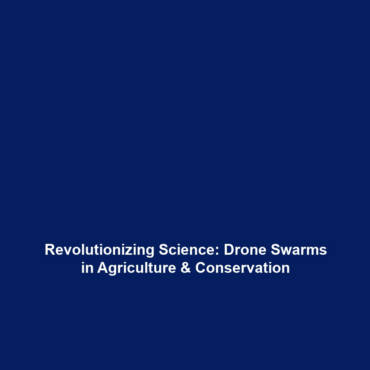Applications of Drone Swarms in Agriculture, Disaster Response, and Wildlife Conservation
Drone swarms represent one of the most promising advancements in technology, providing innovative solutions across various sectors. Their applications in fields like agriculture, disaster response, and wildlife conservation underline the significance of drones in science. With the capability to perform complex tasks collaboratively, drone swarms deploy enhanced efficiency and accuracy, making a substantial impact in these critical areas. This article explores their potential, current challenges, and future innovations.
Key Concepts Behind Drone Swarms
Understanding the applications of drone swarms requires a closer look at several key concepts:
- Autonomous Coordination: Drone swarms operate through sophisticated algorithms that allow for seamless communication and task distribution.
- Data Collection and Analysis: Equipped with various sensors, these drones collect vast data for analysis, crucial for decision-making in agriculture and conservation.
- Scalability: The ability to deploy multiple drones simultaneously enhances operational capabilities, particularly in expansive areas.
Applications and Real-World Uses
The real-world applications of drone swarms in agriculture, disaster response, and wildlife conservation are numerous:
Agriculture
In agriculture, drone swarms are used for:
- Crop Monitoring: Drones monitor crop health through NDVI (Normalized Difference Vegetation Index) analysis, allowing farmers to identify areas in need of attention.
- Precision Agriculture: They assist in precision farming techniques, optimizing resource use like water and fertilizers.
Disaster Response
During disasters, drone swarms are deployed for:
- Search and Rescue: Coordinated flights of drones locate missing persons or assess damage in hard-to-reach areas.
- Real-Time Assessment: Drones provide real-time data to emergency responders, improving operational responses during crises.
Wildlife Conservation
In wildlife conservation, drone swarms are utilized for:
- Monitoring Wildlife: Drones track animal movements and detect poaching activities, aiding in the protection of endangered species.
- Habitat Mapping: Detailed aerial surveys created by drone swarms help in assessing habitat changes and planning conservation strategies.
Current Challenges
Despite their numerous advantages, challenges persist in the field of drones in science. Some of the significant issues include:
- Regulatory Hurdles: Restrictions on airspace and drone operation can limit their effectiveness.
- Technical Limitations: Issues such as battery life and payload capacity can impact operational time and functionality.
- Data Privacy Concerns: The use of drones for surveillance raises questions about privacy and ethical considerations.
Future Research and Innovations
The future of applications of drone swarms in agriculture, disaster response, and wildlife conservation is poised for significant advancements. Key areas of research include:
- Improved AI Algorithms: Ongoing developments in artificial intelligence will enhance swarm intelligence and decision-making capabilities.
- Integration with IoT: The combination of drone technology with Internet of Things (IoT) frameworks will increase data accuracy and accessibility.
- Next-Generation Sensors: Breakthroughs in sensor technology will allow for more sophisticated data collection, vital for resource management.
Conclusion
In conclusion, the applications of drone swarms in agriculture, disaster response, and wildlife conservation represent a crucial development within drones in science. As we continue to harness this technology, addressing current challenges while fostering innovation will be paramount in unlocking their full potential. For further reading on related topics, explore our guides on Drone Technology in Agriculture and The Future of Disaster Management with Drones.

